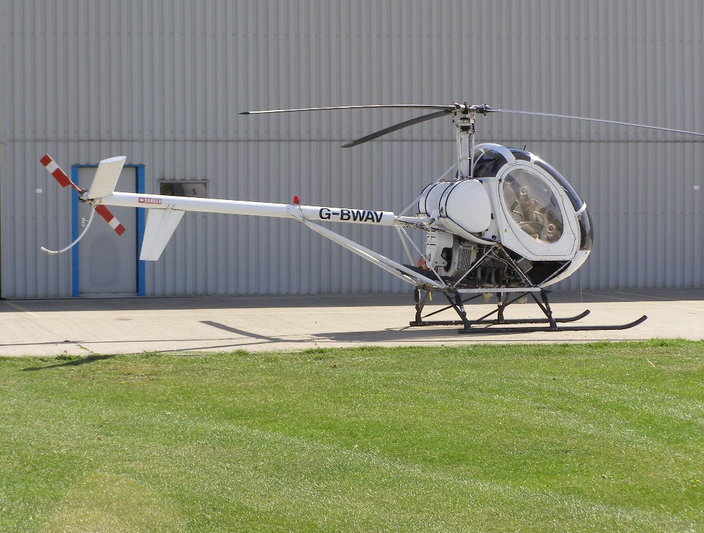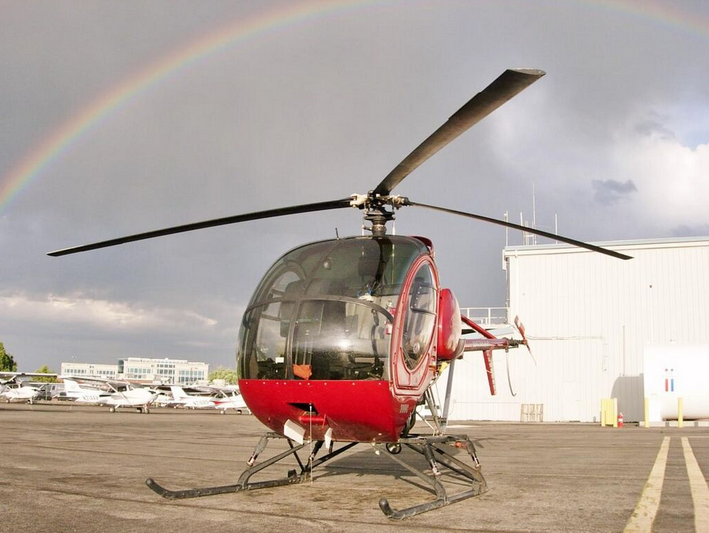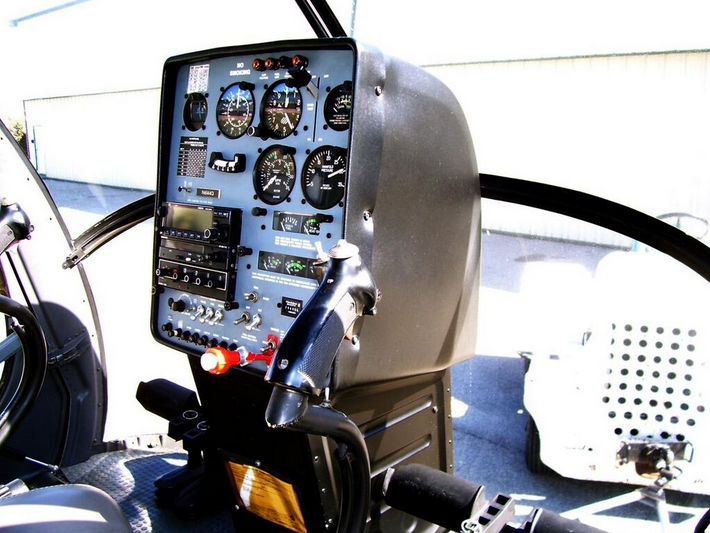
| Version | Summary | Created by | Modification | Content Size | Created at | Operation |
|---|---|---|---|---|---|---|
| 1 | Beatrix Zheng | -- | 1079 | 2022-11-08 01:43:33 | | | |
| 2 | Beatrix Zheng | + 4 word(s) | 1083 | 2022-11-08 04:16:31 | | | | |
| 3 | Beatrix Zheng | Meta information modification | 1083 | 2022-11-08 04:36:12 | | |
Video Upload Options
The Schweizer RSG 300 series (formerly Sikorsky S300, Hughes 300 and Schweizer 300) family of light utility helicopters was originally produced by Hughes Helicopters, as a development of the Hughes 269. Later manufactured by Schweizer Aircraft, the basic design has been in production for almost 50 years. The single, three-bladed main rotor and piston-powered S-300 is mostly used as a cost-effective platform for training and agriculture.
1. Development
1.1. Background
In 1955, Hughes Tool Company's Aircraft Division (later Hughes Helicopters) carried out a market survey showing that there was a demand for a low-cost, lightweight, two-seat helicopter. The division began building the Model 269 in September 1955. The prototype flew on 2 October 1956,[1] but it was not until 1960 that the decision was made to develop the helicopter for production.
On 9 April 1959, the 269 received certification from the Federal Aviation Administration (FAA) and Hughes continued to concentrate on civil production. With some design changes, deliveries of the Model 269A version began in 1961. By mid-1963 about 20 aircraft were being produced per month, and by the spring of 1964 314 had been built. Hughes had successfully captured a large portion of the civilian helicopter market[1] with an aircraft that would prove popular in agriculture, police work and other duties.
1.2. Model 300


In 1964, Hughes introduced the slightly larger three-seat Model 269B which it marketed as the Hughes 300. That same year, the Hughes 269 set an endurance record of 101 hours. To set the record, two pilots took turns piloting the aircraft and hovered in ground-effect for fueling. To ensure no cheating, eggs were attached to the bottom of the skid gear to register any record-ending landing.[1]
The Hughes 300 was followed in 1969 by the improved Hughes 300C (sometimes 269C), which first flew on 6 March 1969 and received FAA certification in May 1970. This new model introduced a more powerful 190 hp (140 kW) Lycoming HIO-360-D1A engine and increased diameter rotor, giving a payload increase of 45%, plus overall performance improvements.[2] It was this model that Schweizer began building under license from Hughes in 1983.[3]
In 1986, Schweizer acquired all rights to the helicopter from McDonnell Douglas, which had purchased Hughes Helicopters in 1984. After Schweizer acquired the FAA Type Certificate, the helicopter was known for a short time as the Schweizer-Hughes 300C and then simply, the Schweizer 300C. The basic design remained unchanged over the years, despite Schweizer making over 250 minor improvements.
Schweizer was purchased on August 26, 2004 by Sikorsky Aircraft. The Schweizer 300 models fill a gap in the Sikorsky helicopter line, which is known for its medium and heavy utility and cargo helicopters.[4]
In February 2009, the 300C was rebranded as the Sikorsky S-300C.[5]
In 2018 the type certificate for the 269 product line was sold by Sikorsky to Schweizer RSG in Fort Worth Texas. The new company, affiliated with Rotorcraft Services Group, will support the existing fleet and will start to build new aircraft at Meacham Airport in Fort Worth, Texas. The management team includes industry and product veterans such as David Horton and Mike Iven. Reference: https://www.aopa.org/news-and-media/all-news/2018/february/28/sikorsky-to-focus-on-larger-helos
1.3. Derivatives
Between Hughes and Schweizer, and including foreign-licensed production civil and military training aircraft, nearly 3,000 units of the Model 269/300 have been built and flown over the last 50 years. Schweizer continued to develop the Model 300 by adding a turbine and redesigning the body to create the Schweizer 330. Further developing the dynamic components to take greater advantage of the power of the turbine engine led to the development of the Schweizer S-333.
In recent years the cockpit received an upgrade when an STC was developed for the installation of the Garmin G500H helicopter dual-screen electronic flight display, as well as the Mid-Continent MD302 Standby Attitude Indicator.[6]
2. Design
The Hughes 269 was created with a fully articulated three-bladed main rotor wherein the blades advance to the right and a two-bladed tail rotor that would remain as distinctive characteristics of all its variants. It also has shock absorber-damped, skid-type landing gear. The flight controls are directly linked to the control surfaces of the helicopter so there are no hydraulics in the 269. There are generally two sets of controls, although this was optional on the civil 269A. For three-seat aircraft, the middle collective control stick is removable and a seat cushion can be put in its place for the third passenger. In the 300CB and 300CBi, the collective control can be repositioned to left-handed configuration for the Pilot In Command position (right seat).
3. Variants


- 269C "Model 300C"
- The 300C is powered by a 190 hp (141 kW) Lycoming HIO-360-D1A and has a larger diameter main rotor (26 ft 10 in compared to 25 ft 4 in). The larger rotor and engine gives it a 45% performance increase over previous 269-series models. Hughes and Schweizer both marketed the 269C as the Model 300C.
- 300CQ
- The Sky Knight is a purpose-built 300C for urban police helicopter patrols with a muffler and other noise attenuating materials and design changes to reduce the helicopter's noise signature by 75%.
- 300CB
- The 300CB is the first pure production of the 300 by Schweizer and is powered by a Textron Lycoming HO-360-C1A, 180 hp engine. The 300CB first flew on 28 May 1993, and was certified by the FAA in August 1995. The 300CB can be reconfigured from a two-seat cockpit to a three-seat configuration. While it is still suited for utility and special missions, this aircraft was designed for helicopter training.
- 300CBi
- A fuel injected version of the 300CB that alleviates carburetor icing concerns in colder temperatures. The 300CBi also includes overspeed protection and automatic rotor engagement during startup, as well as a low rotor RPM warning system.
4. Operators
- Argentina
- Argentine Coast Guard[7]
- Brazil
- Military Police of Rio de Janeiro State[8]
- Colombia
- Greece
- Hellenic Army[11]
Indonesia
- Indonesian Army[12]
- Argentina
- Argentine Coast Guard[7]
- Pakistan
- Pakistan Army[13]
- Thailand
- Royal Thai Army[14]
- Turkey
- Turkish Army[15]
- United States
- Los Angeles County Sheriff's Department[16]
5. Specifications (Schweizer 300C)
Data from International Directiory of Civil Aircraft[3]
General characteristics
- Crew: one pilot
- Capacity: two passengers
- Payload: 950 lb (431 kg)
- Length: 30 ft 10 in (9.4 m)
- Rotor diameter: 26 ft 10 in (8.2 m)
- Height: 8 ft 9 in (2.7 m)
- Disc area: 565 ft2 (52.8 m2)
- Empty weight: 1100 lb (499 kg)
- Loaded weight: 2050 lb (930 kg)
- Max. takeoff weight: 2050 lb (930 kg)
- Powerplant: 1 × Textron Lycoming HIO-360-D1A 4 cylinder, horizontally opposed, 190 hp (141 kW)
Performance
- Maximum speed: 95 kn (109 mph, 176 km/h)
- Cruise speed: 86 kn (99 mph, 159 km/h)
- Range: 195 nmi, 360 km (204 miles)
- Rate of climb: 750 ft/min (3.82 m/s)
References
- "Hughes Model 269A Osage" (.pdf). Evergreen Aviation Museum. 2001. Archived from the original on June 25, 2008. https://web.archive.org/web/20080625152115/http://www.sprucegoose.org/pdfs/planes/General/Hughes269Osage.pdf.
- Frawley, Gerard (2002). The International Directiory of Military Aircraft. Aerospace Publications Pty Ltd. p. 148. ISBN 1-875671-55-2.
- Frawley, Gerard (2003). The International Directiory of Civil Aircraft, 2003-2004. Aerospace Publications Pty Ltd. p. 190. ISBN 1-875671-58-7.
- McKenna, James T.. "Big Plans". Rotor&Wing. Aviation Today. http://www.aviationtoday.com/rw/military/attack/5347.html. Retrieved 2007-10-03.
- "Engineering the Future of Vertical Lift". http://www.sikorsky.com/vgn-ext-templating-SIK/v/index.jsp?vgnextoid=00de6eb78fa78110VgnVCM1000001382000aRCRD&vgnextchannel=162f45d57ef68110VgnVCM1000001382000aRCRD&vgnextfmt=default&pressvcmid=cb796928275af110VgnVCM1000004f62529fRCRD. Retrieved 15 April 2018.
- Pedraza, The University of North Dakota. Juan Miguel. "UND scores unique helicopter training opportunity | 03 | 2014 | Features | UND: University of North Dakota". http://und.edu/features/2014/03/helicopter-training.cfm.
- "Prefectura Naval Argentina 300C". http://www.helis.com/database/modelorg/613/. Retrieved 21 February 2013.
- "Archived copy". Archived from the original on 2013-04-03. https://web.archive.org/web/20130403013135/http://odia.ig.com.br/portal/rio/superc%C3%A2meras-de-aeronaves-v%C3%A3o-patrulhar-as-ruas-do-rio-1.566609. Retrieved 2013-03-31.
- null
- "World 's Air Forces 2004 pg 56". flightglobal.com/pdfarchive/view/1987/1987%20-%202499.html. http://www.flightglobal.com/pdfarchive/view/2004/2004-09%20-%202349.html. Retrieved 2013-02-21.
- "World 's Air Forces 1987 pg 59". flightglobal.com. http://www.flightglobal.com/pdfarchive/view/1987/1987%20-%202509.html. Retrieved 21 February 2013.
- "World 's Air Forces 1987 pg 64". flightglobal.com. http://www.flightglobal.com/pdfarchive/view/1987/1987%20-%202514.html. Retrieved 21 February 2013.
- "Field of Dreams". https://defence.pk/pdf/threads/field-of-dreams.314142/. Retrieved 15 April 2018.
- "World 's Air Forces 1987 pg 95". flightglobal.com. http://www.flightglobal.com/pdfarchive/view/1987/1987%20-%202545.html. Retrieved 21 February 2013.
- "World 's Air Forces 2000 pg 93". flightglobal.com. http://www.flightglobal.com/pdfarchive/view/2000/2000-1%20-%202001.html. Retrieved 21 February 2013.
- "CIVIL HELICOPTER MARKET 1973". flightglobal.com. http://www.flightglobal.com/pdfarchive/view/1973/1973%20-%202131.html. Retrieved 21 February 2013.




